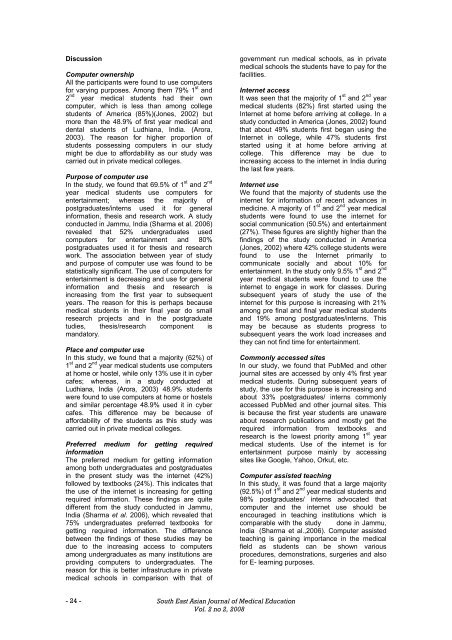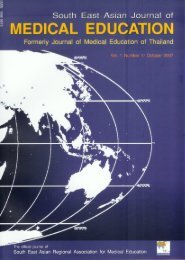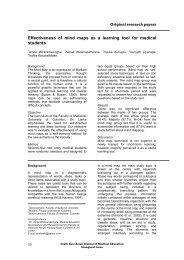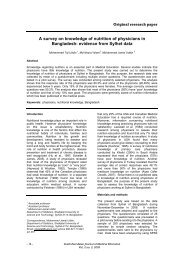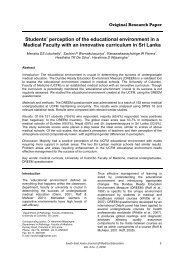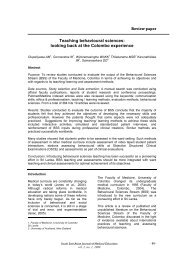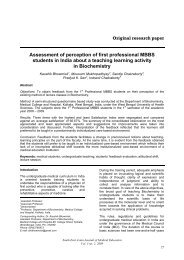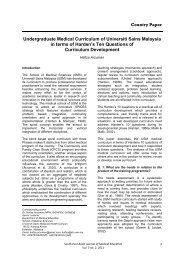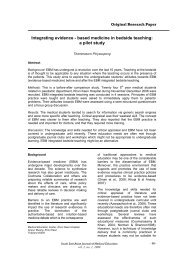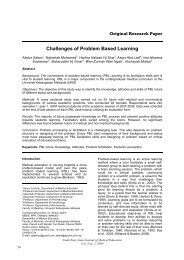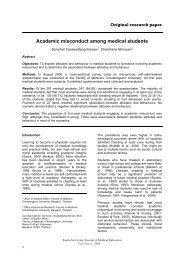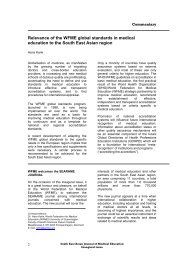Pattern of computer and internet use among medical students in ...
Pattern of computer and internet use among medical students in ...
Pattern of computer and internet use among medical students in ...
Create successful ePaper yourself
Turn your PDF publications into a flip-book with our unique Google optimized e-Paper software.
DiscussionComputer ownershipAll the participants were found to <strong>use</strong> <strong>computer</strong>sfor vary<strong>in</strong>g purposes. Among them 79% 1 st <strong>and</strong>2 nd year <strong>medical</strong> <strong>students</strong> had their own<strong>computer</strong>, which is less than <strong>among</strong> college<strong>students</strong> <strong>of</strong> America (85%)(Jones, 2002) butmore than the 48.9% <strong>of</strong> first year <strong>medical</strong> <strong>and</strong>dental <strong>students</strong> <strong>of</strong> Ludhiana, India. (Arora,2003). The reason for higher proportion <strong>of</strong><strong>students</strong> possess<strong>in</strong>g <strong>computer</strong>s <strong>in</strong> our studymight be due to affordability as our study wascarried out <strong>in</strong> private <strong>medical</strong> colleges.Purpose <strong>of</strong> <strong>computer</strong> <strong>use</strong>In the study, we found that 69.5% <strong>of</strong> 1 st <strong>and</strong> 2 ndyear <strong>medical</strong> <strong>students</strong> <strong>use</strong> <strong>computer</strong>s forenterta<strong>in</strong>ment; whereas the majority <strong>of</strong>postgraduates/<strong>in</strong>terns <strong>use</strong>d it for general<strong>in</strong>formation, thesis <strong>and</strong> research work. A studyconducted <strong>in</strong> Jammu, India (Sharma et al. 2006)revealed that 52% undergraduates <strong>use</strong>d<strong>computer</strong>s for enterta<strong>in</strong>ment <strong>and</strong> 80%postgraduates <strong>use</strong>d it for thesis <strong>and</strong> researchwork. The association between year <strong>of</strong> study<strong>and</strong> purpose <strong>of</strong> <strong>computer</strong> <strong>use</strong> was found to bestatistically significant. The <strong>use</strong> <strong>of</strong> <strong>computer</strong>s forenterta<strong>in</strong>ment is decreas<strong>in</strong>g <strong>and</strong> <strong>use</strong> for general<strong>in</strong>formation <strong>and</strong> thesis <strong>and</strong> research is<strong>in</strong>creas<strong>in</strong>g from the first year to subsequentyears. The reason for this is perhaps beca<strong>use</strong><strong>medical</strong> <strong>students</strong> <strong>in</strong> their f<strong>in</strong>al year do smallresearch projects <strong>and</strong> <strong>in</strong> the postgraduatetudies, thesis/research component ism<strong>and</strong>atory.Place <strong>and</strong> <strong>computer</strong> <strong>use</strong>In this study, we found that a majority (62%) <strong>of</strong>1 st <strong>and</strong> 2 nd year <strong>medical</strong> <strong>students</strong> <strong>use</strong> <strong>computer</strong>sat home or hostel, while only 13% <strong>use</strong> it <strong>in</strong> cybercafes; whereas, <strong>in</strong> a study conducted atLudhiana, India (Arora, 2003) 48.9% <strong>students</strong>were found to <strong>use</strong> <strong>computer</strong>s at home or hostels<strong>and</strong> similar percentage 48.9% <strong>use</strong>d it <strong>in</strong> cybercafes. This difference may be beca<strong>use</strong> <strong>of</strong>affordability <strong>of</strong> the <strong>students</strong> as this study wascarried out <strong>in</strong> private <strong>medical</strong> colleges.Preferred medium for gett<strong>in</strong>g required<strong>in</strong>formationThe preferred medium for gett<strong>in</strong>g <strong>in</strong>formation<strong>among</strong> both undergraduates <strong>and</strong> postgraduates<strong>in</strong> the present study was the <strong><strong>in</strong>ternet</strong> (42%)followed by textbooks (24%). This <strong>in</strong>dicates thatthe <strong>use</strong> <strong>of</strong> the <strong><strong>in</strong>ternet</strong> is <strong>in</strong>creas<strong>in</strong>g for gett<strong>in</strong>grequired <strong>in</strong>formation. These f<strong>in</strong>d<strong>in</strong>gs are quitedifferent from the study conducted <strong>in</strong> Jammu,India (Sharma et al. 2006), which revealed that75% undergraduates preferred textbooks forgett<strong>in</strong>g required <strong>in</strong>formation. The differencebetween the f<strong>in</strong>d<strong>in</strong>gs <strong>of</strong> these studies may bedue to the <strong>in</strong>creas<strong>in</strong>g access to <strong>computer</strong>s<strong>among</strong> undergraduates as many <strong>in</strong>stitutions areprovid<strong>in</strong>g <strong>computer</strong>s to undergraduates. Thereason for this is better <strong>in</strong>frastructure <strong>in</strong> private<strong>medical</strong> schools <strong>in</strong> comparison with that <strong>of</strong>government run <strong>medical</strong> schools, as <strong>in</strong> private<strong>medical</strong> schools the <strong>students</strong> have to pay for thefacilities.Internet accessIt was seen that the majority <strong>of</strong> 1 st <strong>and</strong> 2 nd year<strong>medical</strong> <strong>students</strong> (82%) first started us<strong>in</strong>g theInternet at home before arriv<strong>in</strong>g at college. In astudy conducted <strong>in</strong> America (Jones, 2002) foundthat about 49% <strong>students</strong> first began us<strong>in</strong>g theInternet <strong>in</strong> college, while 47% <strong>students</strong> firststarted us<strong>in</strong>g it at home before arriv<strong>in</strong>g atcollege. This difference may be due to<strong>in</strong>creas<strong>in</strong>g access to the <strong><strong>in</strong>ternet</strong> <strong>in</strong> India dur<strong>in</strong>gthe last few years.Internet <strong>use</strong>We found that the majority <strong>of</strong> <strong>students</strong> <strong>use</strong> the<strong><strong>in</strong>ternet</strong> for <strong>in</strong>formation <strong>of</strong> recent advances <strong>in</strong>medic<strong>in</strong>e. A majority <strong>of</strong> 1 st <strong>and</strong> 2 nd year <strong>medical</strong><strong>students</strong> were found to <strong>use</strong> the <strong><strong>in</strong>ternet</strong> forsocial communication (50.5%) <strong>and</strong> enterta<strong>in</strong>ment(27%). These figures are slightly higher than thef<strong>in</strong>d<strong>in</strong>gs <strong>of</strong> the study conducted <strong>in</strong> America(Jones, 2002) where 42% college <strong>students</strong> werefound to <strong>use</strong> the Internet primarily tocommunicate socially <strong>and</strong> about 10% forenterta<strong>in</strong>ment. In the study only 9.5% 1 st <strong>and</strong> 2 ndyear <strong>medical</strong> <strong>students</strong> were found to <strong>use</strong> the<strong><strong>in</strong>ternet</strong> to engage <strong>in</strong> work for classes. Dur<strong>in</strong>gsubsequent years <strong>of</strong> study the <strong>use</strong> <strong>of</strong> the<strong><strong>in</strong>ternet</strong> for this purpose is <strong>in</strong>creas<strong>in</strong>g with 21%<strong>among</strong> pre f<strong>in</strong>al <strong>and</strong> f<strong>in</strong>al year <strong>medical</strong> <strong>students</strong><strong>and</strong> 19% <strong>among</strong> postgraduates/<strong>in</strong>terns. Thismay be beca<strong>use</strong> as <strong>students</strong> progress tosubsequent years the work load <strong>in</strong>creases <strong>and</strong>they can not f<strong>in</strong>d time for enterta<strong>in</strong>ment.Commonly accessed sitesIn our study, we found that PubMed <strong>and</strong> otherjournal sites are accessed by only 4% first year<strong>medical</strong> <strong>students</strong>. Dur<strong>in</strong>g subsequent years <strong>of</strong>study, the <strong>use</strong> for this purpose is <strong>in</strong>creas<strong>in</strong>g <strong>and</strong>about 33% postgraduates/ <strong>in</strong>terns commonlyaccessed PubMed <strong>and</strong> other journal sites. Thisis beca<strong>use</strong> the first year <strong>students</strong> are unawareabout research publications <strong>and</strong> mostly get therequired <strong>in</strong>formation from textbooks <strong>and</strong>research is the lowest priority <strong>among</strong> 1 st year<strong>medical</strong> <strong>students</strong>. Use <strong>of</strong> the <strong><strong>in</strong>ternet</strong> is forenterta<strong>in</strong>ment purpose ma<strong>in</strong>ly by access<strong>in</strong>gsites like Google, Yahoo, Orkut, etc.Computer assisted teach<strong>in</strong>gIn this study, it was found that a large majority(92.5%) <strong>of</strong> 1 st <strong>and</strong> 2 nd year <strong>medical</strong> <strong>students</strong> <strong>and</strong>98% postgraduates/ <strong>in</strong>terns advocated that<strong>computer</strong> <strong>and</strong> the <strong><strong>in</strong>ternet</strong> <strong>use</strong> should beencouraged <strong>in</strong> teach<strong>in</strong>g <strong>in</strong>stitutions which iscomparable with the study done <strong>in</strong> Jammu,India (Sharma et al.,2006). Computer assistedteach<strong>in</strong>g is ga<strong>in</strong><strong>in</strong>g importance <strong>in</strong> the <strong>medical</strong>field as <strong>students</strong> can be shown variousprocedures, demonstrations, surgeries <strong>and</strong> als<strong>of</strong>or E- learn<strong>in</strong>g purposes.- 24 -South East Asian Journal <strong>of</strong> Medical EducationVol. 2 no 2, 2008


